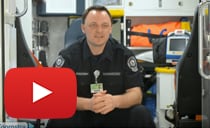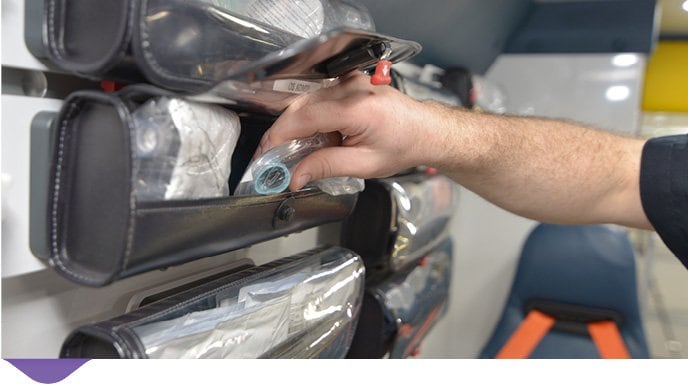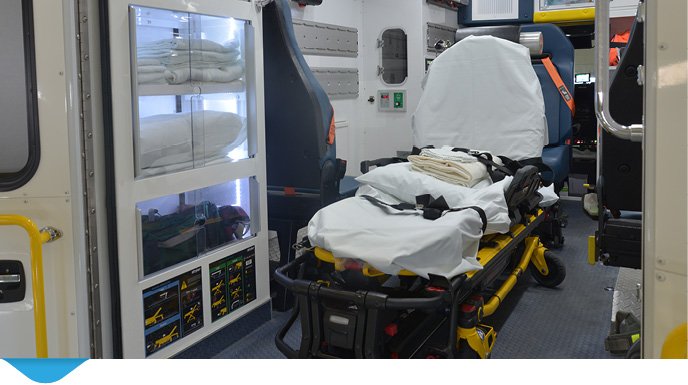Ambulance Services
Available 24 hours a day, seven days a week, MICS offers staff and services for a variety of medical needs and emergencies. On average, MICS paramedics receive 80 calls a week—that’s over 4,000 a year. They include:
- 911 calls
- Inter-facility emergency and critical care transfers
- Routine scheduled transfers to other hospitals and healthcare organizations, including long-term care and assisted living
- EMS coverage of mass events in community
- In-hospital emergency response for cardiac arrests
- Fire and other emergencies
- Security and surveillance on hospital campus
Specialized training for certified MICS includes Paramedic Specialist Certification, aggressive behavior management, and hazardous materials operations. In addition, MICS staff works closely with First Responder units across central Iowa providing training and support.

At the Ready
Get a look inside our Mobile Intensive Care Services.
Watch the Video
A Better Ambulance

Inside the Ambulance
Go inside Mary Greeley's new emergency response vehichles designed for safety of patients and paramedics.
Watch the Video Tour.
Mary Greeley’s new ambulances are designed to be safer for patients and paramedics.
You may think that the ambulances don’t quite look like your prototypical emergency vehicle. They may look more like a moving truck. That is no surprise. These ambulances have been placed on a Freightliner chassis, which is the same kind you’d find on U-Haul trucks. The reason is simple: fuel-efficiency. Placing the boxes on this type of chassis allows the ambulances to average 14.1 miles to the gallon, which is almost double what more traditional ambulances get.

Crumple Zone
Lightweight plastics used in the front of Mary Greeley’s ambulances can absorb energy from an impact by creating a “crumple zone.” This zone acts as a cushion to protect the occupants of the ambulance, as well as people inside the other vehicle involved in a collision.
In March 2018, a new Allina Health ambulance with a “crumble zone” was involved in a crash that involved another car. Five people were involved the accident, including those in the ambulance. Nobody was seriously injured.

Efficient Storage
Ambulances need cabinets for supplies. The Icon 2.0’s FERNO iNTRAXX system helps reduce the number of cabinets, allowing for more room for crew and patients. It also lessens the likelihood of a patient or paramedic sustaining an injury from falling items.
The system is installed in such a way that paramedics are able to reach everything they need from a sitting position. The pouches that accompany the system can be put wherever the crews need them and are safely secured. This helps paramedics to be more efficient, while keeping supplies secure. Mary Greeley paramedics played a central role in creating the iNTRAXX configuration for the new ambulances.

Backpack Seatbelts
Ambulances typically have bench seating on either side, with the patient in the middle. The bench seating positions the paramedics so they are looking directly at the patient.
These seats, often referred to as squad benches, are equipped with rarely used seatbelts. Emergency situations don’t always lend themselves to buckling and unbuckling a seatbelt. Because of this, paramedics often find themselves unrestrained.
According to a study by the Emergency Medical Services division of the National Highway Traffic Safety Administration, there are 4,500 vehicle crashes involving an ambulance every year. In 84 percent of those accidents, paramedics in the patient compartment were not restrained.
In Mary Greeley’s new ambulances, all of the seats either forward-face or rear-face, and are equipped with what is referred to as a backpack seatbelt. This harness slips over a paramedic’s shoulders. It allows the paramedic full mobility. They are still able to turn to the side to tend to the patient, they are able to stand up and access equipment needed to care for the patient being transported. It acts much like a regular seatbelt and should an accident occur, could protect the paramedics from serious injury.

Cot Loader
One of the most recognizable pieces of equipment inside an ambulance is the gurney, or stretcher, on to which patients are loaded. Mary Greeley’s new ambulances have been outfitted with a Stryker Power Load Power Cot. This power system loads and unloads cots with the touch of a button. This protects the paramedics from injuries that can occur by lifting and lowering patients into the back of the ambulance. It also makes it easier on the patients, as the loading and unloading that occurs is a much smoother process. Once inside the ambulance, the robust fastener system that accompanies the lift allows the cot to be secured to the floor of the ambulance.

Iowa's First Paramedic Service
Mary Greeley has been a leader in emergency medical response.
For a good stretch of time, ambulance service in Ames was provided by a funeral home.
That changed on Jan. 1, 1973, when Mary Greeley took over the service from Stevens Funeral Home. The first paramedics went out of state to become certified, as the state of Iowa had no such designation.
It was not until 1979, when Iowa created its Advanced Care Law for Emergency Medical Services, that Mary Greeley was officially recognized as the first paramedic service in Iowa and became known as Mobile Intensive Care Services, or MICS. Shortly after, Mary Greeley became authorized to provide teaching and testing for certifications of all paramedics within Iowa.
Mary Greeley had the first paramedic class in the state and went on to provide advanced care training for nearly two decades, until paramedic and EMT programs started be offered at schools around the state.
While technology has changed in the past 40 years, as has ambulances and emergency response processes, one thing has remained a constant: the level of care Mary Greeley paramedics provide.